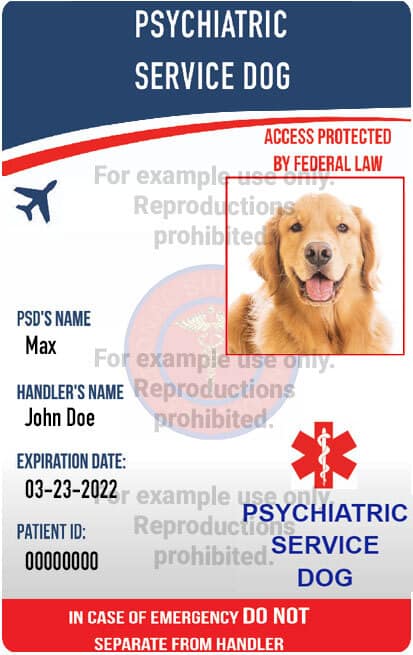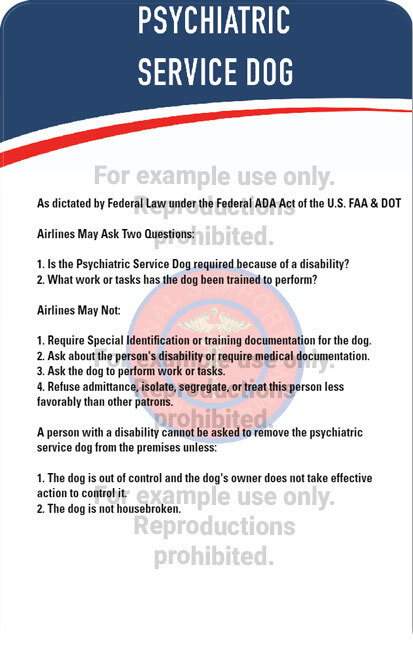A psychiatric service dog is a type of assistance animal that’s specially trained to perform a certain task or action for an individual living with a mental health disability.
Because they’re recognized as service animals under the Americans with Disabilities Act, psychiatric service dogs have federally protected rights that grant them access to public places such as grocery stores, restaurants, and educational facilities. Psychiatric service dogs are also granted travel privileges that allow them to ride in airline cabins with their handlers, and they’re also permitted in housing accommodations, even if there’s a “no pets” policy in place.
When traveling with your psychiatric service dog, whether it’s for every day tasks like running errands and visiting the grocery store or whether it’s for a more formal trip where you’ll be boarding a train or airplane, you may find it’s beneficial to distinguish your service animal in a way that clearly identifies they are a working dog currently on duty.
This can prevent others from crowding the dog and wanting to pet them, which can distract your PSD from performing their tasks and which can also make some PSD handlers uncomfortable.
The best way to distinguish your assistance animal is by outfitting them with a service vest and service ID card.
What’s a Psychiatric Service Dog ID Card?

A Psychiatric Service Dog ID Card is a special form of identification that clearly distinguishes your assistance animal from a normal, every-day pet. The ID card services to communicate that your psychiatric service dog is a working dog currently on duty.
Service vests and ID cards serve two important functions:
First: they inform the staff of a publish establishment (including airline and other transportation staff) that your assistance animal is not a pet and therefore has certainly federally protected rights and privileges (such as access to public places where pets are normally not allowed).
Second: they inform the public that your assistance animal is currently on duty and therefore should not be disturbed. This gives you peace of mind, as you won’t have to worry about your PSD being distracted from their work nor have to deal with strangers approaching or crowding around you.
While the ADA does not require service animals to wear a special vest, ID tag, patch, or harness, it’s strongly encouraged to outfit your dog with these items, as it can make travel and every-day errands more convenient and stress-free. Again, service apparel helps distinguish your animal from normal pets and allows the staff of public facilities to clearly see that the dog’s presence is required because of a special need.
What Should a Psychiatric Service Dog ID Card Include?

The front of the ID card should include your dog’s name, your own name, the ID’s expiration date, and the Patient ID number you received from your consultation with a Licensed Mental Health Professional. The ID should also clearly communicate the type of assistance animal you have (in this case, the wording: Psychiatric Service Dog should appear at least twice on the front of the ID card), and the card should also communicate that your PSD should not be separated from you at any point.
Another important part of your service dog’s ID card is the information it provides on the backside. This information clearly communicates that your psychiatric service dog has federally protected rights and privileges that allow them access to public facilities, including onboard airplanes.
The ID card further explains what staff members of a public accommodation (including airline and other transportation staff) are allowed to ask you under ADA guidelines, and more importantly, what they’re not allowed to do (e.g. ask you to identify your disability, ask that your dog to demonstrate their task, or refuse admittance, isolate, segregate, or treat you less favorably than other patrons.)
Under ADA guidelines, staff members can legally ask PSD owners only two questions:
- Is the Psychiatric Service Dog required because of a disability?
- What work or task has the dog been trained to perform?
Many PSD owners find it incredibly beneficial to have a Service Dog ID Card on hand, as it saves them the trouble from having to inform individuals over and over again about their assistance animal’s public access rights as well as their own rights under the Americans with Disabilities Act. Instead, they can simply show a staff member the ID card to answer any questions the person might have.
How Do I Purchase a Psychiatric Service Dog ID Card?
Once you’ve purchased a Psychiatric Service Dog letter consultation with CertaPet, you can log into your client dashboard and navigate to the ‘Purchase ID Card & Vest’ section.
Here, you’ll see all the options available when it comes to IDs, vests, and patches for your PSD.
Where Should I Place the Psychiatric Service Dog ID Card?
The most common way to display your PSD’s ID card is by attaching it to their service dog vest. Most vests will come equipped with a D-ring on the topside for easy leash attachment, as well as for the attachment of an ID card. Simply place your dog’s ID in a special, clip-on ID card holder (widely available for purchase online), and then attach it to their vest’s D-ring.
Some PSD owners find it helpful to have multiple ID cards on hand as well. You can keep one in your purse or wallet, one in your car’s glove compartment, and one in your carry-on for traveling. This way, should you ever misplace or lose your dog’s primary ID card, you still have others on-hand that you can rely on.
